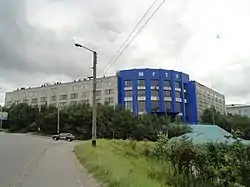Murmansk
Мурманск | |
|---|---|
| Other transcription(s) | |
| • Kildin Sami | Мурман ланнҍ |
| • Northern Sami | Murmánska |
| • Skolt Sami | Muurman[2] |
 View of Murmansk celebrating the 65th anniversary of liberation of the Soviet Transarctic | |
 Coat of arms | |
Location of Murmansk | |
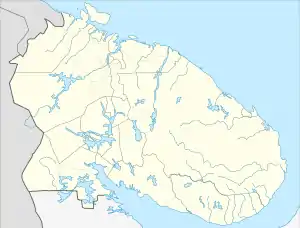 Murmansk Location of Murmansk .svg.png.webp) Murmansk Murmansk (European Russia)  Murmansk Murmansk (Europe) | |
| Coordinates: 68°58′14″N 33°04′30″E / 68.97056°N 33.07500°E | |
| Country | Russia |
| Federal subject | Murmansk Oblast[1] |
| Official foundation date (see text) | October 4, 1916[3] |
| City status since | July 19, 1916[3] |
| Government | |
| • Body | Council of Deputies |
| • Head/Mayor | Dmitry Filippov (Head) Evgeniy Nikora (Mayor) |
| Elevation | 50 m (160 ft) |
| Population | |
| • Estimate (2018)[4] | 295,374 |
| • Rank | 61st in 2010 |
| • Subordinated to | City of Murmansk[1] |
| • Capital of | Murmansk Oblast,[1] City of Murmansk[1] |
| • Urban okrug | Murmansk Urban Okrug[5] |
| • Capital of | Murmansk Urban Okrug[5] |
| Time zone | UTC+3 (MSK |
| Postal code(s)[7] | 183000–183099 |
| Dialing code(s) | +7 8152 |
| OKTMO ID | 47701000001 |
| City Day | October 4[8] |
| Website | www |

Murmansk (Russian: Мурманск; Kildin Sami: Мурман ланнҍ; Skolt Sami: Muurman[2] and Northern Sami: Murmánska) is a port city and the administrative center of Murmansk Oblast in the far northwest part of Russia. It sits on both slopes and banks of a modest ria or fjord, Kola Bay, an estuarine inlet of the Barents Sea, with its bulk on the east bank of the inlet. It is in the north of the rounded Kola Peninsula which covers most of the oblast. The city is 108 kilometres (67 mi) from the border with Norway and 182 kilometres (113 mi) from the border with Finland.
Benefiting from the North Atlantic Current, Murmansk resembles cities of its size across western Russia, with highway and railway access to the rest of Europe, and the northernmost trolleybus system on Earth. It lies over 2° north of the Arctic Circle. Its connectivity contrasts with the isolation of Arctic ports like the Siberian Dikson on the shores of the Kara Sea, and Iqaluit, in the Canadian Arctic. Despite long, snowy winters, Murmansk's climate is moderated by the generally ice-free waters around it.
Although there was a building boom in the early twentieth century's arms races, Murmansk's population has been in decline since the Cold War, from 468,039 (1989 Census);[9] 336,137 (2002 Census);[10] 307,257 (2010 Census);[11] to 270,384 (2021 Census).[12] It remains the world's largest city north of the Arctic Circle, with over 100,000 more inhabitants than Norilsk, Russia, and is a major port of the Arctic Ocean.[13]
Etymology
The name of the city is derived from Murman, from an old name for Norwegians by Russians, likely a borrowing from Old Norse norðmaðr, which gave its name to the Murman Coast and the surrounding region including the Kola Peninsula.[14]
History
%252C_1936_%D0%B3.jpg.webp)

Murmansk was the last city founded in the Russian Empire.[15] In 1915, World War I needs led to the construction of the railroad from Petrozavodsk to an ice-free location on the Murman Coast in the Russian Arctic, to which Russia's allies shipped military supplies.[3] The terminus became known as the Murman station and soon boasted a port, a naval base, and an adjacent settlement with a population that quickly grew in size and soon surpassed the nearby towns of Alexandrovsk and Kola.[3][16]
On June 29 [O.S. July 12], 1916, Russian Transport Minister Alexander Trepov petitioned to grant urban status to the railway settlement.[3] On July 6 [O.S. July 19], 1916, the petition was approved and the town was named Romanov-on-Murman (Рома́нов-на-Му́рмане, Romanov-na-Murmane), after the Imperial Russian dynasty of Romanovs.[3] On September 21 [O.S. October 4], 1916, the official ceremony was performed,[3] and the date is now considered the official date of the city's foundation. After the February Revolution of 1917, on April 3 [O.S. April 16], 1917, the town was given its present name.[17]
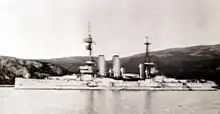
In the winter of 1917 the British North Russia Squadron under Rear Admiral Thomas Kemp was established at Murmansk.[18]
From 1918 to 1920, during the Russian Civil War, the town was occupied by the Western powers, who had been allied in World War I, and also controlled by the White Army forces.[19]
On February 13, 1926, local self-government was organized in Murmansk for the first time, during a plenary session of the Murmansk City Soviet, which elected a Presidium.[17] Before this, the city was governed by the authorities of Alexandrovsky Uyezd and later of Murmansk Governorate.[17] On August 1, 1927, the All-Russian Central Executive Committee (VTsIK) issued two resolutions: "On the Establishment of Leningrad Oblast" and "On the Borders and Composition of the Okrugs of Leningrad Oblast", which transformed Murmansk Governorate into Murmansk Okrug within Leningrad Oblast and made Murmansk the administrative center of Murmansk Okrug.[17]
In 1934, the Murmansk Okrug Executive Committee developed a redistricting proposal, which included a plan to enlarge the city by merging the surrounding territories in the north, south, and west into Murmansk.[17] While this plan was not confirmed by the Leningrad Oblast Executive Committee, in 1935–1937 several rural localities of Kolsky and Polyarny Districts were merged into Murmansk anyway.[17]
According to the Presidium of the Leningrad Oblast Executive Committee resolution of February 26, 1935, the administrative center of Polyarny District was moved from Polyarnoye to Sayda-Guba.[20] However, the provisions of the resolution were not fully implemented, and due to military construction in Polyarnoye, the administrative center was instead moved to Murmansk in the beginning of 1935.[20] In addition to being the administrative center of Murmansk Okrug, Murmansk continued to serve as the administrative center of Polyarny District until September 11, 1938.[17] On February 10, 1938, when the VTsIK adopted a Resolution changing the administrative-territorial structure of Murmansk Okrug, the city of Murmansk became a separate administrative division of the okrug, equal in status to that of the districts.[17] This status was retained when Murmansk Okrug was transformed into Murmansk Oblast on May 28, 1938.[17] The Germans were promised the use of the port, they called Norwegenhafen for transportation of goods and raw materials from 1922 to 1941.
During World War II, Murmansk was a link to the Western world for the Soviet Union with large quantities of goods important to the respective military efforts traded with the Allies: primarily seeing military equipment, manufactured goods and raw materials brought into the Soviet Union. The supplies were brought to the city in the Arctic convoys.[21]
German forces in Finnish territory launched an offensive against the city in 1941 as part of Operation Silver Fox. Murmansk suffered extensive destruction, the magnitude of which was rivaled only by the destruction of Leningrad and Stalingrad.[22][23] However, fierce Soviet resistance and harsh local weather conditions with the bad terrain prevented the Germans from capturing the city and cutting off the vital Karelian railway line and the ice-free harbor.
The Luftwaffe bombed the city 792 times during World War II.[24]
For the rest of the war, Murmansk served as a transit point for weapons and other supplies entering the Soviet Union from other Allied nations. This resistance was commemorated at the 40th anniversary of the victory over the Germans in the formal designation of Murmansk as a Hero City on May 6, 1985.[25] During the Cold War Murmansk was a center of Soviet submarine and icebreaker activity. After the dissolution of the Soviet Union, the nearby city and naval base of Severomorsk remains the headquarters of the Russian Northern Fleet.
In 1974, a massive 35.5-meter (116 ft) tall statue Alyosha, depicting a Soviet World War II soldier, was installed on a 7-meter (23 ft) high foundation.[26] The Hotel Arctic opened in 1984 becoming the tallest building above the Arctic Circle.
On January 1, 2015, the territory of Murmansk was expanded when the urban-type settlement of Roslyakovo, previously under the jurisdiction of the closed administrative-territorial formation of Severomorsk, was abolished and its territory merged into Murmansk.[27]
Administrative and municipal status
Within the framework of administrative divisions, it is incorporated as the City of Murmansk—an administrative unit with the status equal to that of the districts.[1] As a municipal division, the City of Murmansk is incorporated as Murmansk Urban Okrug.[5]
City divisions

As of 2012, the city is divided into three administrative okrugs:[28]
- Leninsky (Ленинский (Lenin))
- Oktyabrsky (Октябрьский (October))
- Pervomaysky (Первомайский (First May))
City districts were established in Murmansk for the first time by the Decree of the Presidium of the Supreme Soviet of the Russian SFSR of April 20, 1939; at the time, three city districts (Kirovsky, Leninsky, and Mikoyanovsky) were created.[17] They were abolished on June 2, 1948.[17] The same city districts were created for the second time on June 23, 1951.[17]
Mikoyanovsky City District was renamed Oktyabrsky on October 30, 1957, but on September 30, 1958, all three city districts were again abolished.[17] On June 10, 1967, two city districts were created (Leninsky and Oktyabrsky); Pervomaysky City District was split from Oktyabrsky on February 21, 1975.[17] In the Charter of the Hero City of Murmansk, adopted on December 17, 1995, the districts started to be referred to as administrative okrugs.
Geography

Climate
Murmansk experiences a subarctic climate (Köppen Dfc), with long and cold winters and short, cool summers. In the city, freezing temperatures are routinely experienced from October to May. Average temperatures exceed 0 degrees Celsius only from May through October. The average low during the coldest part of the year in Murmansk is approximately −14 °C (7 °F). However, temperatures routinely plunge below −20 °C (−4 °F) during the winter.
Murmansk's brief summer is mild, with average highs in July exceeding +17 °C (63 °F). The city is slightly wetter during the summer than the winter and receives an annual average of just under 500 mm (20 in) of precipitation.
The "midnight sun" is above the horizon from 22 May to 23 July (63 days), and the period with continuous darkness lasts a bit shorter, polar night from 2 December to 10 January (40 days).
Extreme temperatures range from −39.4 °C (−38.9 °F) on January 6, 1985 and January 27, 1999 up to 32.9 °C (91.2 °F) on July 9, 1972; the record cold daily maximum is −36.1 °C (−33.0 °F), set on January 6, 1985, while, conversely, the record warm daily minimum is 21.3 °C (70.3 °F) last set on July 9, 1972.[29]
Murmansk has been affected by global warming in recent decades, similar to other Arctic locations. For example, December 2007 had an average high of 0.8 °C (33.4 °F), while a 2.3 °C (36.1 °F) average high was measured for March 2007.[30][31] Summer has also been affected, with a 19.1 °C (66.4 °F) average high for June 2013, and a 24.3 °C (75.7 °F) average high during July 2018.[32][33]
| Climate data for Murmansk (1991–2020, extremes 1918–present) | |||||||||||||
|---|---|---|---|---|---|---|---|---|---|---|---|---|---|
| Month | Jan | Feb | Mar | Apr | May | Jun | Jul | Aug | Sep | Oct | Nov | Dec | Year |
| Record high °C (°F) | 7.0 (44.6) |
6.6 (43.9) |
9.0 (48.2) |
17.6 (63.7) |
29.4 (84.9) |
30.8 (87.4) |
32.9 (91.2) |
30.2 (86.4) |
24.2 (75.6) |
15.0 (59.0) |
9.6 (49.3) |
7.2 (45.0) |
32.9 (91.2) |
| Mean maximum °C (°F) | 1.7 (35.1) |
2.0 (35.6) |
4.5 (40.1) |
10.3 (50.5) |
19.1 (66.4) |
24.4 (75.9) |
26.9 (80.4) |
23.9 (75.0) |
17.8 (64.0) |
9.7 (49.5) |
3.9 (39.0) |
2.9 (37.2) |
27.7 (81.9) |
| Mean daily maximum °C (°F) | −6.5 (20.3) |
−6.4 (20.5) |
−1.9 (28.6) |
2.9 (37.2) |
8.4 (47.1) |
13.8 (56.8) |
17.7 (63.9) |
15.3 (59.5) |
10.7 (51.3) |
3.6 (38.5) |
−1.8 (28.8) |
−4.1 (24.6) |
4.3 (39.7) |
| Daily mean °C (°F) | −9.6 (14.7) |
−9.3 (15.3) |
−5.1 (22.8) |
−0.3 (31.5) |
4.6 (40.3) |
9.4 (48.9) |
13.2 (55.8) |
11.5 (52.7) |
7.6 (45.7) |
1.6 (34.9) |
−4.0 (24.8) |
−6.8 (19.8) |
1.1 (34.0) |
| Mean daily minimum °C (°F) | −12.7 (9.1) |
−12.3 (9.9) |
−8.2 (17.2) |
−3.3 (26.1) |
1.5 (34.7) |
5.9 (42.6) |
9.6 (49.3) |
8.3 (46.9) |
5.1 (41.2) |
−0.3 (31.5) |
−6.2 (20.8) |
−9.6 (14.7) |
−1.8 (28.8) |
| Mean minimum °C (°F) | −25.1 (−13.2) |
−24.4 (−11.9) |
−19.1 (−2.4) |
−12.1 (10.2) |
−3.8 (25.2) |
1.2 (34.2) |
5.2 (41.4) |
3.2 (37.8) |
−0.4 (31.3) |
−8.1 (17.4) |
−16.4 (2.5) |
−20.7 (−5.3) |
−28.5 (−19.3) |
| Record low °C (°F) | −39.4 (−38.9) |
−38.6 (−37.5) |
−32.6 (−26.7) |
−24.0 (−11.2) |
−10.3 (13.5) |
−2.8 (27.0) |
1.7 (35.1) |
−2.0 (28.4) |
−10.1 (13.8) |
−21.2 (−6.2) |
−32.2 (−26.0) |
−34.9 (−30.8) |
−39.4 (−38.9) |
| Average precipitation mm (inches) | 34 (1.3) |
24 (0.9) |
29 (1.1) |
29 (1.1) |
37 (1.5) |
56 (2.2) |
66 (2.6) |
71 (2.8) |
54 (2.1) |
56 (2.2) |
36 (1.4) |
37 (1.5) |
529 (20.8) |
| Average extreme snow depth cm (inches) | 26 (10) |
28 (11) |
30 (12) |
19 (7.5) |
2 (0.8) |
0 (0) |
0 (0) |
0 (0) |
0 (0) |
3 (1.2) |
11 (4.3) |
19 (7.5) |
30 (12) |
| Average rainy days | 2 | 2 | 3 | 9 | 18 | 22 | 22 | 22 | 24 | 17 | 5 | 3 | 149 |
| Average snowy days | 27 | 26 | 24 | 19 | 14 | 4 | 0.03 | 0.1 | 2 | 16 | 24 | 27 | 183 |
| Average relative humidity (%) | 84 | 83 | 79 | 73 | 72 | 70 | 75 | 79 | 80 | 83 | 86 | 85 | 79 |
| Mean monthly sunshine hours | 1.9 | 44.5 | 133.4 | 188.6 | 205.2 | 234.8 | 249.4 | 165.4 | 108.3 | 51.7 | 5.8 | 0 | 1,389 |
| Source 1: Pogoda.ru.net[34] | |||||||||||||
| Source 2: NOAA[35] Infoclimat[36] | |||||||||||||
| Sea temperature data for Murmansk | |||||||||||||
|---|---|---|---|---|---|---|---|---|---|---|---|---|---|
| Month | Jan | Feb | Mar | Apr | May | Jun | Jul | Aug | Sep | Oct | Nov | Dec | Year |
| Average sea temperature °C (°F) | 3.4 (38.12) |
2.5 (36.5) |
1.9 (35.42) |
2.2 (35.96) |
3.9 (35.96) |
7.1 (44.78) |
10.5 (50.9) |
10.9 (51.62) |
9 (48.2) |
7 (44.6) |
5.3 (41.54) |
4.6 (40.28) |
5.69 (42.245) |
| Source:[37] | |||||||||||||
Demographics
| Year | Pop. | ±% |
|---|---|---|
| 1926 | 8,716 | — |
| 1939 | 117,069 | +1243.2% |
| 1959 | 221,874 | +89.5% |
| 1970 | 308,642 | +39.1% |
| 1979 | 380,817 | +23.4% |
| 1989 | 468,039 | +22.9% |
| 2002 | 336,137 | −28.2% |
| 2010 | 307,257 | −8.6% |
| 2021 | 270,384 | −12.0% |
| Source: Census data | ||
.jpg.webp)
The population of the city, according to the 2010 Census, was 307,257, of these, 141,130 men (45.9%) and 166,127 women (54.1%),[38][39] down from 468,039 recorded in the 1989 Census. Since the collapse of the Soviet Union, the city has been consistently losing population, as the extensive military facilities the city is built around have declined. Ethnic Russians make up the majority of the population, but Ukrainian and Belarusian minorities also live in the city.
Ethnic composition (2010):[40]
- Russians – 89.6%
- Ukrainians – 4.6%
- Belarusians – 1.6%
- Tatars – 0.8%
- Azerbaijanis – 0.7%
- Others – 2.6%
Politics
In November 2010 direct mayoral elections were abolished; they were reinstituted in January 2014, with the most recent elections for mayor and city council taking place in September 2014.[41]
Museums and monuments
Murmansk has two main museums: Murmansk Oblast Museum and Murmansk Oblast Art Museum; there are also several small museums. There are three professional theaters, libraries, and an aquarium in Murmansk. Murmansk is the venue of the decommissioned Lenin which is now a museum ship. Alyosha Monument, Murmansk or Defenders of the Soviet Arctic during the Great Patriotic War monument is also located in Murmansk. The main square of Murmansk is Five Corners, Murmansk.
 Lenin, converted into a museum ship
Lenin, converted into a museum ship Monument of sailors in Murmansk
Monument of sailors in Murmansk Memorial to Defenders of the Soviet Arctic during the Great Patriotic War
Memorial to Defenders of the Soviet Arctic during the Great Patriotic War Monument to the victims of the intervention of 1918–1920, Murmansk
Monument to the victims of the intervention of 1918–1920, Murmansk
Culture
There are three professional theaters in Murmansk. The oldest is the Murmansk Puppetry, which opened in 1933. The largest in the city was the Murmansk Regional Drama Theater, which opened in 1939. The Drama Theater of the Northern Fleet was opened in 1946.[42]
 Drama Theater of the Northern Fleet
Drama Theater of the Northern Fleet Murmansk Regional Drama Theater
Murmansk Regional Drama Theater Murmansk Puppetry
Murmansk Puppetry
Sports
The city's association football team, FC Sever Murmansk, played in the Russian Second Division until 2014 when it folded due to financial difficulties.
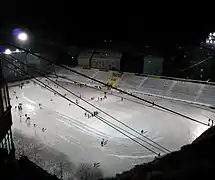
 Bandy at Stroitel stadium
Bandy at Stroitel stadium
 Murmansk Municipal Swimming Pool
Murmansk Municipal Swimming Pool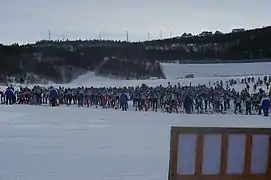 Polar Olympiada in 2013
Polar Olympiada in 2013
Bandy club Murman[43] has played in the Russian Bandy Super League, last in 2011–2012. Between 2012 and 2018 they were playing in the second tier Russian Bandy Supreme League, but will from the 2018–19 season be a Super League team again.[44] Their home arena, Stadium Stroitel, has an audience capacity of 5,000.[45]
The city is one of only three places with representation in the female league, through the team Arktika.[46] Proximity to pole and its side effects, Polar Night, has brought sport festivals such as North Festival Polar Olympiad and Sun Festival. The former has been awarded every year since the inaugural tournament in 1934.[47] Norway, Finland, Sweden, Ukraine, Belarus and the Baltic countries take part in the North Festival Polar Olympiad.[48]
Religion
To commemorate the 85th anniversary of the city's foundation, the snow-white Church of the Saviour on the Waters was modeled after the White Monuments of Vladimir and Suzdal and built on the shore for the sailors of Murmansk.[49]
Fifteen religious associations have been registered in Murmansk.[50] The largest is the Russian Orthodox Church, Murmansk is the center of its Murmansk and Monchegorsk diocese, as well as the Murmansk Metropolis. The city has about a dozen Orthodox churches, the department of the head of the diocese and the metropolis of Metropolitan Simon is located in St. Nicholas Cathedral.[51][52]
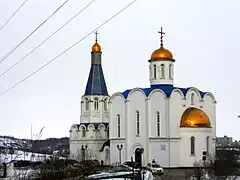 Church of the Saviour on the Waters, Murmansk
Church of the Saviour on the Waters, Murmansk.jpg.webp) St. Michael the Archangel's Church
St. Michael the Archangel's Church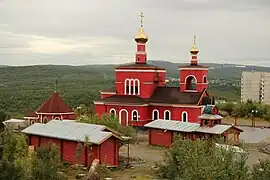 All Saints' Church
All Saints' Church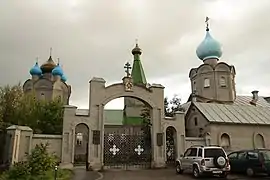 St. Nicholas Cathedral
St. Nicholas Cathedral
Economy
Media
Murmansk's evening newspaper is Vecherniy Murmansk, published since 1991.
Transportation
The port of Murmansk remains ice-free year round due to the warm North Atlantic Current and is an important fishing and shipping destination. It is home port to Atomflot, the world's only fleet of nuclear-powered icebreakers.[53]
The Port of Murmansk is the headquarters of Sevmorput (Northern Sea Route) and the administration of Russian Arctic maritime transport. In 2018, the Russian government transferred the main responsibility for the Northern Sea Route to Rosatom which through its ROSATOMFLOT subsidiary manages the Russian nuclear powered icebreaker fleet based in Murmansk.[54][55]
Murmansk is linked by the Kirov Railway to St. Petersburg and is linked to the rest of Russia by the M18 Kola Motorway. Murmansk Airport provides air links to Moscow and St. Petersburg.
Buses and trolleybuses provide local transport.
 Murmansk central rail station
Murmansk central rail station
 Trolley Ziu-682 with Azimut Hotel Murmansk in the background
Trolley Ziu-682 with Azimut Hotel Murmansk in the background An interchange of the Eastern Bypass Road and Planernaya Street
An interchange of the Eastern Bypass Road and Planernaya Street_AN1445818.jpg.webp)
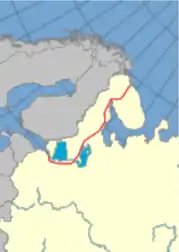 Kirov Railway connects Murmansk city and Saint Petersburg.
Kirov Railway connects Murmansk city and Saint Petersburg..svg.png.webp)
Arctic Bridge
Murmansk is set to be the Russian terminus of the Arctic Bridge, a sea route linking it to the Canadian port of Churchill, Manitoba. Even though the passage has not been fully tested for commercial shipping yet, Russian interest in this project (along with the Northwest Passage) is substantial, as the bridge will serve as a major trade route between North America, Europe and Asia.[56]
Education
Murmansk is home to Murmansk State Technical University, the Murmansk Arctic State University (formerly Murmansk State Pedagogical University), the Murmansk Institute of Humanities and the Murmansk College of Arts[57] (the only Art School of the Kola Peninsula, formerly the 'Murmansk Music School'). The city has 86 primary schools and 56 secondary schools, two boarding schools, and three reform schools. There is also a branch of the Naval Academy in Murmansk, where cadets study, who in the future should become officers of the Russian Navy.
Twin towns – sister cities
Former Twin towns – sister cities
 Szczecin (1993–2022) Cancelled as a result of the 2022 Russian invasion of Ukraine
Szczecin (1993–2022) Cancelled as a result of the 2022 Russian invasion of Ukraine Rovaniemi (1962–2022) Cancelled as a result of Russian invasion of Ukraine.[59][60]
Rovaniemi (1962–2022) Cancelled as a result of Russian invasion of Ukraine.[59][60] Tromsø (1972–2022) Cancelled because of concerns related to the 2022 Russian invasion of Ukraine[61]
Tromsø (1972–2022) Cancelled because of concerns related to the 2022 Russian invasion of Ukraine[61] Akureyri, Iceland (1994–2022) Cancelled as a result of the 2022 Russian invasion of Ukraine[62]
Akureyri, Iceland (1994–2022) Cancelled as a result of the 2022 Russian invasion of Ukraine[62]
Notable people
- Nikita Alexeev, ice hockey player
- Vitaliy Nikolayevich Bubentsov, Russian artist
- Aleksey Goman, pop singer
- Kate Grigorieva, supermodel
- Valentina Gunina, chess grandmaster
- Halyna Hutchins, cinematographer and journalist
- Vladimir Konstantinov, ice hockey player
- Irina Kovalenko, supermodel and Miss Russia winner
- Larisa Kruglova, sprinter
- Sergey Kuryokhin, actor and musician
- Irina Malgina, biathlete
- Elizaveta Nazarenkova, Uzbek rhythmic gymnast
- Yevgeny Nikitin, opera singer
- Zlata Ognevich, Ukrainian singer
- Sergei Rozhkov, biathlete
- Alexei Semenov, ice hockey player
- Sergey Subbotin, former mayor
- Konstantin Volkov, ice hockey player
- Vitaly Zdorovetskiy, YouTube personality, prankster
- Yana Kunitskaya, UFC bantamweight fighter
References
Notes
- 1 2 3 4 5 6 Law #96-01-ZMO
- 1 2 "Muurman (subst. erisnimi)". Neahttadigisánit. Retrieved October 11, 2023.
- 1 2 3 4 5 6 7 Administrative-Territorial Division of Murmansk Oblast, p. 24
- ↑ "26. Численность постоянного населения Российской Федерации по муниципальным образованиям на 1 января 2018 года". Federal State Statistics Service. Retrieved January 23, 2019.
- 1 2 3 Law #531-01-ZMO
- ↑ "Об исчислении времени". Официальный интернет-портал правовой информации (in Russian). June 3, 2011. Retrieved January 19, 2019.
- ↑ "Main Murmansk post office". Archived from the original on February 26, 2012. Retrieved July 18, 2010.
- ↑ Stepanova, Anna (September 29, 2017). "День города в Мурманске 2017: программа праздника и перекрытия дорог". Komsomolskaya Pravda. Retrieved November 20, 2017.
- ↑ Всесоюзная перепись населения 1989 г. Численность наличного населения союзных и автономных республик, автономных областей и округов, краёв, областей, районов, городских поселений и сёл-райцентров [All Union Population Census of 1989: Present Population of Union and Autonomous Republics, Autonomous Oblasts and Okrugs, Krais, Oblasts, Districts, Urban Settlements, and Villages Serving as District Administrative Centers]. Всесоюзная перепись населения 1989 года [All-Union Population Census of 1989] (in Russian). Институт демографии Национального исследовательского университета: Высшая школа экономики [Institute of Demography at the National Research University: Higher School of Economics]. 1989 – via Demoscope Weekly.
- ↑ Russian Federal State Statistics Service (May 21, 2004). Численность населения России, субъектов Российской Федерации в составе федеральных округов, районов, городских поселений, сельских населённых пунктов – районных центров и сельских населённых пунктов с населением 3 тысячи и более человек [Population of Russia, Its Federal Districts, Federal Subjects, Districts, Urban Localities, Rural Localities—Administrative Centers, and Rural Localities with Population of Over 3,000] (XLS). Всероссийская перепись населения 2002 года [All-Russia Population Census of 2002] (in Russian).
- ↑ Russian Federal State Statistics Service (2011). Всероссийская перепись населения 2010 года. Том 1 [2010 All-Russian Population Census, vol. 1]. Всероссийская перепись населения 2010 года [2010 All-Russia Population Census] (in Russian). Federal State Statistics Service.
- ↑ "Оценка численности постоянного населения по субъектам Российской Федерации". Federal State Statistics Service. Retrieved September 1, 2022.
- ↑ "10 Largest Cities Within the Arctic Circle".
- ↑ Этимологический словарь русского языка Макса Фасмера. p. Мурман.
- ↑ The Moscow Times. It's Always Colder in Murmansk Archived September 10, 2015, at the Wayback Machine, May 20, 2012
- ↑ Hill, Alexander (2007). "Russian and Soviet Naval Power and the Arctic from the XVI Century to the Beginning of the Great Patriotic War". The Journal of Slavic Military Studies. 20 (3): 359–392. doi:10.1080/13518040701532958. S2CID 145005700.
- 1 2 3 4 5 6 7 8 9 10 11 12 13 14 Administrative-Territorial Division of Murmansk Oblast, pp. 60–63
- ↑ Clifford Kinvig (November 23, 2007), Churchill's Crusade, Hambledon & London, ISBN 9781847250216, OCLC 747256147, OL 9819337M, 1847250211
- ↑ "Bolshevik, North Russian, Royal Navy, Expeditionary Force, Archangel, Dvina River". Naval-history.net. Retrieved December 8, 2010.
- 1 2 Administrative-Territorial Division of Murmansk Oblast, p. 48
- ↑ Hill, Alexander (2007). "British Lend Lease Aid and the Soviet War Effort, June 1941 – June 1942". The Journal of Military History. 71 (3): 773–808. doi:10.1353/jmh.2007.0206. JSTOR 30052890. S2CID 159715267.
- ↑ Мурманску исполняется 90 лет(in Russian)
- ↑ "Газета «Вечерний Мурманск» Выпуск № 93 от 28 мая 2005". Archived from the original on June 20, 2016.
- ↑ Hansen, Trond. 25 June 2021. "Dagen for mot og utholdenhet" [day of courage and endurance]. Sør-Varanger Avis. P.10
- ↑ "Nature Administrative-territorial system". 2004.murman.ru. October 4, 1916. Retrieved May 5, 2009.
- ↑ "Alyosha, granite monument on Russia's Litsa River".
- ↑ Law #1812-01-ZMO
- ↑ Charter of Murmansk, Article 3.1
- ↑ "Météo Climat stats for Mourmansk" (in French). Météo Climat. Retrieved October 13, 2018.
- ↑ "December 2007" (in Russian). Roshydromet. Retrieved November 11, 2019.
- ↑ "March 2007" (in Russian). Roshydromet. Retrieved November 11, 2019.
- ↑ "June 2013" (in Russian). Roshydromet. Retrieved November 11, 2019.
- ↑ "July 2018" (in Russian). Roshydromet. Retrieved November 11, 2019.
- ↑ Климат Мурманска [The Climate of Murmansk]. Weather and Climate (Погода и климат) (in Russian). Retrieved November 8, 2021.
- ↑ "Murmansk Climate Normals 1991–2020". National Oceanic and Atmospheric Administration. Retrieved November 3, 2021.
- ↑ "Climatologie de l'année à Murmansk" (in French). Infoclimat. Retrieved October 12, 2023.
- ↑ "Погода в Мурманске сейчас. Температура воды в море. Подробный прогноз. Мурманск на карте погоды".
- ↑ Статистический сборник Численность, размещение и возрастно-половой состав населения Мурманской области. Итоги Всероссийской переписи населения. Том 1. 2012 Archived December 22, 2012, at the Wayback Machine / Федеральная служба государственной статистики, Территориальный орган Федеральной службы государственной статистики по Мурманской области. Мурманск, 2012 — 75 с.
- ↑ "Численность населения Мурманской области по полу на 14 октября 2010 года". Retrieved January 10, 2019.
- ↑ "Распределение населения Мурманской области по наиболее многочисленным национальностям по муниципальным образованиям". Archived from the original on March 3, 2016. Retrieved September 15, 2021.
- ↑ "Выборы мэра Мурманска пройдут 14 сентября »". 2014-2015.vybor-naroda.org. Archived from the original on February 1, 2014.
- ↑ "Наыеярбн » Йскэрспю – Лсплюмяй Х Лсплюмяйюъ Накюярэ". Region.murman.ru. Retrieved March 3, 2022.
- ↑ "Google Translate". translate.google.com. Retrieved July 3, 2017.
- ↑ "Google Translate".
- ↑ "Google Translate". Translate.google.se. Retrieved March 12, 2013.
- ↑ "Информация о команде "Арктика" Мурманск - Реестр - Федерация хоккея с мячом России". rusbandy.ru.
- ↑ "Праздник Севера". Archived from the original on November 21, 2021. Retrieved November 21, 2021.
- ↑ "Международный Праздник Севера - Полярная Олимпиада". norse.ru. Archived from the original on June 19, 2010. Retrieved January 11, 2022.
- ↑ see photograph Archived October 11, 2006, at the Wayback Machine)
- ↑ "Религиозные объединения". Официальный портал Мурманской области. Archived from the original on December 21, 2012. Retrieved January 10, 2019.
- ↑ "Храмы епархии". Сайт Мурманской и Мончегорской епархии. Archived from the original on June 20, 2012. Retrieved June 15, 2012.
- ↑ "Культура, образование, наука, спорт, церковь". Администрация города Мурманска – официальный сайт. Archived from the original on December 11, 2017. Retrieved June 15, 2012.
- ↑ "Atomflot – Bellona". Bellona. Archived from the original on July 16, 2011. Retrieved December 7, 2010.
- ↑ Nilsen, Thomas (July 18, 2018). "Vyacheslav Ruksha will lead the newly established Northern Sea Route Directorate". The Barents Observer. Archived from the original on November 12, 2020. Retrieved December 17, 2020.
- ↑ Henderson, Isaiah (July 18, 2019). "Cold Ambition: The New Geopolitical Faultline". The California Review. Archived from the original on November 12, 2020. Retrieved December 17, 2020.
- ↑ "Chinese goods may come to US via Murmansk". Barentsnova. August 18, 2014. Archived from the original on September 12, 2014.
- ↑ Мурманский колледж искусств [Murmansk College of Arts]. mki-51.ru (in Russian). Archived from the original on September 19, 2017. Retrieved July 3, 2017.
- ↑ "Сведения об официальной деятельности". citymurmansk.ru (in Russian). Murmansk. Archived from the original on May 31, 2020. Retrieved February 3, 2020.
- ↑ "Szczecin wypowiedział umowę o przyjacielskiej współpracy z Murmańskiem". wszczecinie.pl (in Polish). Retrieved March 7, 2022.
- ↑ "The capital of Lapland freezes partnership with Murmansk". The Independent Barents Observer. Retrieved March 7, 2022.
- ↑ https://www.nrk.no/tromsogfinnmark/tromso-avslutter-vennskapsbyavtale-med-russiske-byer-1.16153548. NRK.no. Retrieved 2022-10-26
- ↑ "Murmansk terminates sister city relations with Akureyri", The Barents Observer, 15 December 2022
Sources
- Мурманская областная Дума. Закон №96-01-ЗМО от 6 января 1998 г. «Об административно-территориальном устройстве Мурманской области», в ред. Закона №1953-01-ЗМО от 24 декабря 2015 г. «О внесении изменений в Закон Мурманской области "Об административно-территориальном устройстве Мурманской области"». Опубликован: "Мурманский Вестник", №10, стр. 3, 16 января 1998 г. (Murmansk Oblast Duma. Law #96-01-ZMO of January 6, 1998 On the Administrative-Territorial Structure of Murmansk Oblast, as amended by the Law #1953-01-ZMO of December 24, 2015 On Amending the Law of Murmansk Oblast "On the Administrative-Territorial Structure of Murmansk Oblast". ).
- Мурманская областная Дума. Закон №531-01-ЗМО от 2 декабря 2004 г. «О статусе муниципального образования город Мурманск». Вступил в силу 1 января 2005 г. Опубликован: "Мурманский Вестник", №234, стр. 3, 7 декабря 2004 г. (Murmansk Oblast Duma. Law #531-01-ZMO of December 2, 2004 On the Status of the Municipal Formation of the City of Murmansk. Effective as of January 1, 2005.).
- Совет депутатов города Мурманска. Решение №20-235 от 10 марта 2006 г. «Устав муниципального образования город Мурманск», в ред. Решения №15-202 от 4 февраля 2010 г «О внесении изменений в Устав муниципального образования город Мурманск, утверждённый Решением Совета Депутатов города Мурманска от 10.03.2006 (с изменениями и дополнениями от 31.05.2006 №23-263, от 05.10.2006 №24-298), с последующими изменениями, внесёнными Решениями Совета депутатов города Мурманска от 13.11.2007 №43-529, от 03.04.2008 №48-588 и от 03.06.2009 №5-57». Вступил в силу в соответствии со статьёй 81. Опубликован: "Вечерний Мурманск", спецвыпуск, стр. 1–12, 10 ноября 2006 г. (Council of Deputies of the City of Murmansk. Decision #20-235 of March 10, 2006 Charter of the Municipal Formation of the City of Murmansk, as amended by the Decision #15-202 of February 4, 2010 On Amending the Charter of the Municipal Formation of the City of Murmansk, Adopted by the Decision of the Council of Deputies of the City of Murmansk of March 10, 2006 (with the Amendments and Supplements #23-263 of May 31, 2006, #24-298 of October 5, 2006), with Subsequent Amendments, Introduced by the Decisions of the Council of Deputies of the City of Murmansk #43-529 of November 13, 2007, #48-588 of April 3, 2008, and #5-57 of June 3, 2009. Effective as of the day determined by the provisions of Article 81.).
- Архивный отдел Администрации Мурманской области. Государственный Архив Мурманской области. (1995). Административно-территориальное деление Мурманской области (1920–1993 гг.). Справочник. Мурманск: Мурманское издательско-полиграфическое предприятие "Север".
- Мурманская областная Дума. Закон №1812-01-ЗМО от 19 декабря 2014 г. «Об упразднеии населённого пункта Мурманской области и о внесении изменений в отдельные законодательные акты Мурманской области». Вступил в силу 1 января 2015 г. Опубликован: "Мурманский Вестник", №246–247, с. 56, 25 декабря 2014 г. (Murmansk Oblast Duma. Law #1812-01-ZMO of December 19, 2014 On Abolishing an Inhabited Locality in Murmansk Oblast and on Amending Various Legislative Acts of Murmansk Oblast. Effective as of January 1, 2015.).
External links
- Official website of Murmansk (in Russian)
- News of Murmansk
- Interactive map of Murmansk Archived May 15, 2017, at the Wayback Machine
- Barentsnova.com, Murmansk business news, statistics
- Atomic ice breaker fleet
- Murmansk's gorgeous garages — a photo journal by BBC news journalist Jorn Madslien
- Views of Murmansk group on Flickr
- Video overview of Murmansk in English, 4½ minutes, 2009
- Murmansk State Technical University
- British North Russian Expeditionary Force 1918–1919 (based at Murmansk)
- "Big-dollar deals tempt Arctic firms" BBC article on the energy industry's effect on Murmansk
